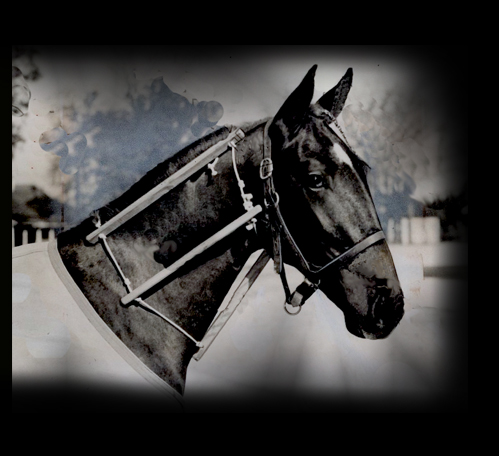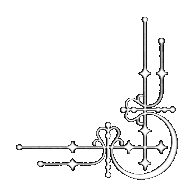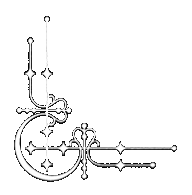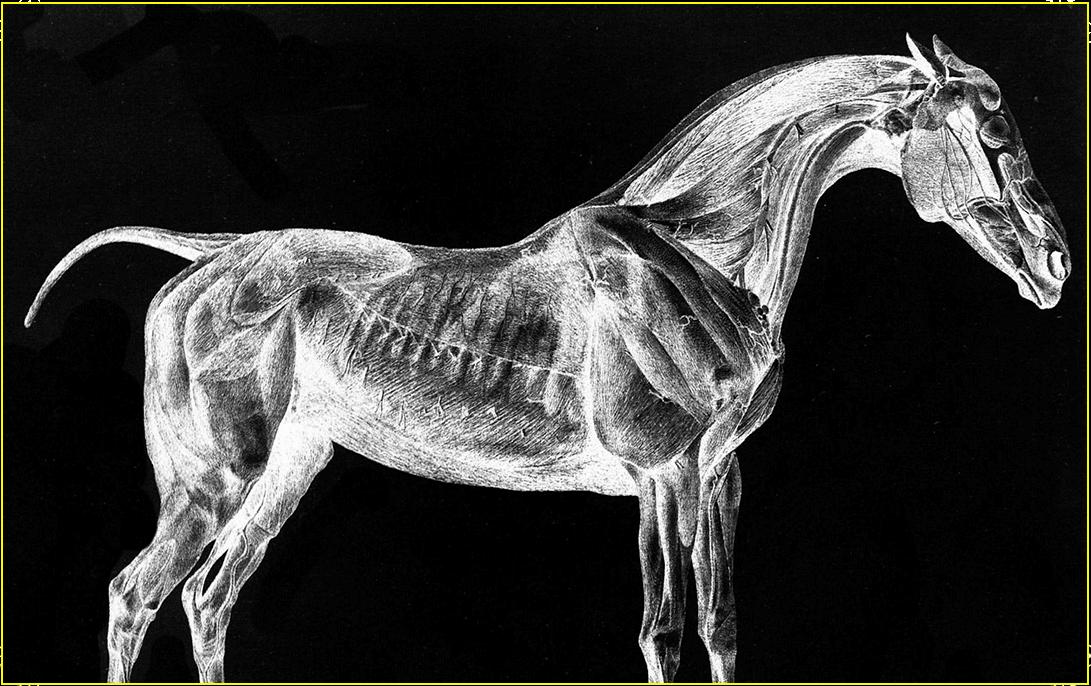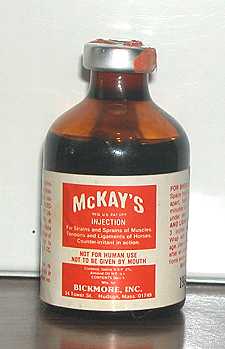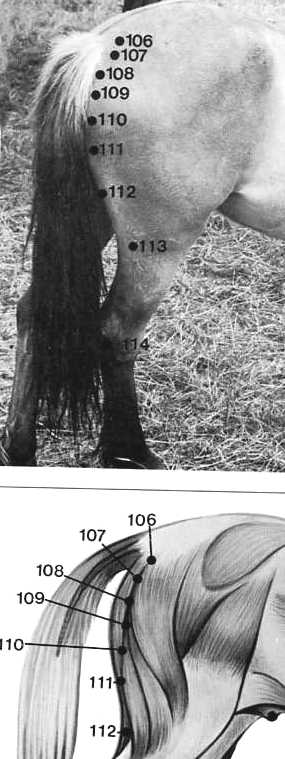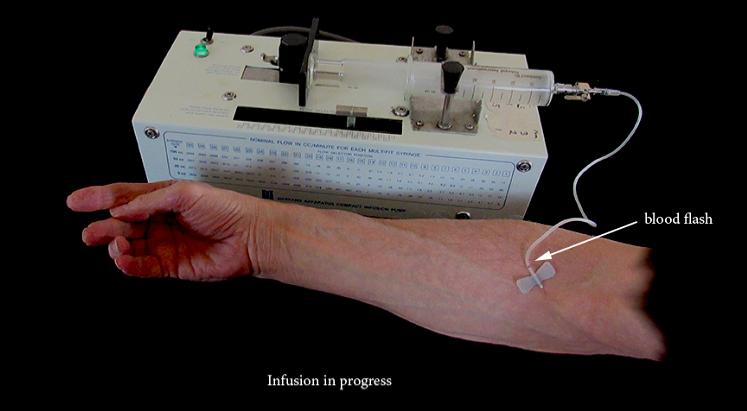Below is an excerpt from Veterinary Materia Medica and Therapeutics by Kenelm Winslow, published in 1913:
Counter-Irritants
A counter-irritant is an irritant which acts counter, or against an existing irritation, result of irritation, or pain. In applying a "twitch" to a horse, we are inflicting an irritation to relieve some other source of irritation elsewhere. It is taken for granted that the damage and pain caused by the artificial irritant are not as severe as those already existing. The amount of injury produced by an irritant depends upon the nature of the material, its strength, the duration of its action, the mode of application, and the part to which it is applied. We may consider the effects occasioned by a mild and increasing action following the continued use of a single agent, or representing the action of materials of different degrees of potency. There first appears redness of the skin, accompanied by some burning or pain (rubefacient action), and if the irritation progresses there is a serious exudates poured out into the mucous layer of the skin. This leads to swelling and edema. Greater irritation causes more exudation of serum and an elevation of the epidermis is a circumscribed area or areas, and the formation of blebs or blisters (vesication). If the irritation ceases at this point, the blisters break open and their contents dry on the surface, covering the parts with a thick scab. Synchronous with vesication we observe a similar process attacking the hair follicles. The hairs are loosened and fall, but as the papillae are usually unaffected, the growth of hair is soon renewed. The recovery of hair is facilitated by the application of grease to parts. Certain agents cause circumscribed inflammation of the gland orifices of the skin with the formation of pustules (postulants), as croton oil, and these create necrosis of the hair papillae, and, therefore permanent loss of hair. If the irritant is severe, suppuration follows vesication; or, if an ordinary irritant is applied with violent friction, is covered with a bandage, or placed over an already inflamed part, the same result happens. The terms referring to the degree of action inherent in agents are as follows:
1. A rubefacient, causing hyperemia.
2. A vesicant, or epispastic, inducing blistering.
3. A postulant, creating pustules.
4. An escharotic or caustic, occasioning death of the tissues.
The same agent, as has already been pointed out, may produce one or more of these actions according to circumstances. The inner aspect of limbs and the flexures of joints are peculiarly sensitive owing to the thinness of the skin over these areas. If a counter-irritant is rubbed properly into the skin, it may penetrate into the mucous layer.
Reference has been made to the local influence of irritants. We will now direct attention to their remote effect. It is certainly known that irritation of the surface decidedly affects distant organs. Brown-Sequard noted contraction of vessels in one arm when the other was immersed in cold water. Severe burns of the surface are followed by duodenal ulcers. The preceding and succeeding remarks enable us to partially account for the remote influence of counter-irritants, but although we know their practical value, it is not within our present knowledge to offer theories wholly explaining their effect.
The influence of counter-irritants may be summed up in reflex action; i.e. the production and conduction of an impulse from the periphery to nerve centers, thereby modifying the nerve functions and blood supply in distant parts.
The skin is commonly the point of application. It normally is an organ of protection, respiration, secretion and special sense, and, through its medium, a regulator of temperature, responding to such natural stimuli as heat, cold, moisture and dryness. Such an unnatural and considerable stimulation as is produced by counter-irritants consequently creates very sensible alterations in the bodily functions. Extensive counter-irritation causes the breathing to become slower and deeper by reflex stimulation of the respiratory center and also by making the respiratory movements more painful, if the application be made to the chest wall. The circulation is likewise affected by stimulation of the vagus and vasomotor centers, and both the force of the heart and blood pressure are increased, unless the irritation is very widespread and severe, when the reverse happens. The abdominal vessels are those constricted; the vessels of the skin and the limbs are unaffected. In accordance with the foregoing remarks the use of considerable heat, together with mustard or turpentine, is of great value in conditions of vital depression, surgical shock, collapse, and coma. Moreover, the effect on local blood supply is still greater and full of importance, since it may explain the beneficial action obtained in the ordinary use of counter-irritants. In experiments conducted upon animals, it has been observed that when sinapisms are placed over the head, the blood vessels in the pia mater are first dilated, but soon contract and remaining in that condition for some time. Likewise there was seen, following energetic counter-irritation of the chest, anemia of the underlying parts, including the muscles, pleura, and even the pulmonary tissue. It is essential to bear in mind, then, that while counterirritants induce local congestion in their immediate vicinity, they also cause reflex vascular contraction in more remote areas. In accordance with this demonstration, the important of these agents in remote inflammation lay not so much in their bringing blood to the surface, as in forcing it out of distant parts. This fact is not generally appreciated. The use of the word, "drawing" signifies the common idea of counter-irritant, and implies the first proposition.
Temperature is not materially affected by therapeutic use of counter-irritants, and they are not necessarily contraindicated in fevers. Experiments, however, appear to show that mild counter-irritation may lead to a slight elevation of body-heat, owing to stimulation of the calorifacient centers, while extensive and prolonged action lowers temperature by depression of the heart and heat centers, and because more blood flows through the peripheral vessels owing to constriction of the vessels in the abdominal organs.
Counter-irritants notably relieve pain. This result is not only due to overcoming congestion, but occurs when pain is purely neuralgic. The phenomenon is not altogether explicable. The subduing influence of the twitch in the case of pain inflicted upon a horse is an analogous example. Wechsberg, in some late experiments, notes, as a most striking effect of counter-irritants, edematous infiltration of the skin, subcutaneous tissue and muscle is sub-adjacent parts, with compression of blood vessels in the deeper-lying structures. He attributes the relief of pain afforded by counter-irritants to anemia and rapid compression brought to bear on the nerves in these underlying parts.
Still this explanation does not interpret the relief of pain sometimes seen in parts remote from the point of application of counter-irritants.
I n disease of internal organs, Head has constantly found certain corresponding areas of skin tenderness. This because both the internal organ and the skin area are innervated from the same segment of the brain or cord. Theoretically and practically counter-irritation of a skin area affects the internal organ corresponding (by nervous connection) to this area more than other parts. These areas of skin tenderness for diseased internal organs, and for application of skin irritants to relieve these conditions, have been mapped out in man. In the case of the chest and belly they are situated pretty nearly over the site of the internal organ. In the head the sensitive skin-sites are not over the diseased part.
Pain is usually referable to the peripheral ends of an affected nerve. It is a good practice to apply counter-irritation directly over a deep seated inflammation or seat of pain (see above), but in assuaging superficial pain it is found, that where the treatment can be made over the root of the painful nerve, better results are obtained. In pain in the chest wall, a blister should be placed next the spine over the root of the spinal nerve involved; in pain in the head in man, counter-irritation is applied over the back of the neck. Counter-irritation should be done over the temple, in pain in the eye (iritis); behind the ear, for pain in that organ.
In treatment of enlarged glands and in acute inflammations, as abscess, boils and carbuncles, by counter-irritants the application should be about the lesions rather than directly upon them.
Among other actions accomplished by counter-irritants are: possible stimulation of trophic nerves and nutrition of a part; augmentation of tissue change, locally and generally, and dilation of vessels (when applied after the subsidence of acute inflammation or in chronically inflamed parts), with renewed activity of the circulation and consequent absorption of inflammatory exudations. The local action of skin irritants increases the leucocytes and opsinins in inflammatory area (acted upon) and leads to bacterial destruction. The toxins are also more rapidly removed by their influence. Furthermore, counter-irritants reflexly overcome spasm and pain occurring in colic, by stimulating and replacing normal peristaltic action in place of abnormal localized contractions. In like manner, they excite uterine contractions by stimulation of the involuntary muscular fibers of the womb.
Indications for Counter-irritants:
1. To overcome congetion and inflammation in remote parts.
2. To promote absorption of inflammatory products locally.
3. To relieve pain.
4. To stimulate the heart, respiration, and nervous functions.
Rubefacients. --- In this class are included the volatile oils: turpentine, oil of wintergreen, etc.; alcohol chloroform, balsams, resins, iodine, tincture of camphor, tincture of cantharides, mustard, and heat. These agents are used when it is desirable to stimulate the nervous system rapidly, and to relieve pain and congestion. To attain this end, we employ comparatively mild agents in order that we may apply them over an extensive surface without causing serious or permanent results. Mustard is rubbed with warm water into a thin paste (a sinapism), and rubbed over the chest of horses in congestion of the lungs, in acute bronchitis, or in the first stage of pleuritis, to obtund pain and lessen congestion. Sinapisms also relieve obstinate cough, revive failing respiration, and stimulate reflexly the vital functions in collapse, shock and narcotic coma. Applied over the cardiac region, they avert syncope. To assist the action of mustard, we often cover the application with hot blankets, and then with dry ones. Stimulating liniments are sometimes preferred. One volume of oil of mustard may be combined with fifteen volumes of oil of turpentine; or ammonia water, thirty parts, and oil of turpentine, fifteen parts, are added to spirit of camphor and soap liniment, each fifty parts.
Turpentine is more valuable in abdominal disorders in horses. It is sprinkled on hot blankets, and applied as a stupe to stop pain, spasm, and stimulate normal peristalsis in colic; and to relieve pain and congestion in enteritis, peritonitis, diarrhea and other difficulties. The beneficial result accruing from the use of external counter-irritants in bowel troubles is often facilitated by the injection of hot (115 degrees F) rectal enemata.
Stimulating liniments are serviceable in aiding resolution of swelling following the acute stage of cellulites, lymphangitis, neuritis, mammitis, rheumatism, strains and bruises. They are often employed in laryngitis. In chronic skin diseases, as eczema, mild counter-irritants (tar, oil of cade, Peruvian balsam, etc) substitute an active reparative process, tend to aid absorption of exudation and induration, and relieve pain and itching. The tincture of iodine may abort incipient inflammatory lesions as boils and abscess, by means of its counter-irritant and antiseptic properties.
Vesicants and the Actual Cautery.
Cantharides, red iodide of mercury, and croton oil are more commonly used in veterinary medicine to cause blistering. Reference will be had, hereafter, to cantharidal blisters. Blisters and the cautery are especially indicated to cause resolution of inflammatory products and modifications of inflammatory processes; to secure fixation and rest of parts, and to relieve pain. It is impossible to enumerate all the conditions in which they are useful. In the treatment of severe sprains, as curb and "breakdown"; and in exostoses, as ringbone and spavin, the actual cautery (firing) is used before and in conjunction with blistering to exaggerate the counter-irritant effect. Absorption is attained in the foregoing conditions by production of an acute inflammation, with increase of vascularity, tissue change and fatty degeneration. In "breakdown" the formation of scar tissue is thought (without reason) to assist in supporting the limb. Sometimes, on the other hand, osseous deposit is unabsorbed, but anchylosis and freedom from pain in a diseased joint is secured by the enforced maintenance of rest and fixation of the joint, together with the production of the new bone.
In exudative diseases of serous membranes, as pleuritis, percarditis, peritonitis, meningitis, arthritis, and synovitis, blisters facilitate absorption and recovery after the acute stage is over. The favorable result is not due to loss of serum, but to modification of the inflammatory process. In the first three diseases named above, blisters-flying blisters-may be applied in spots every few days in different places over the affected area.
Blisters reflexly stimulate the nerve centers in meningitis, in addition to their action on the inflammatory lesion. They should be applied over the poll or spine according to the location of the trouble. Absorption in chronically enlarged glands is assisted by blisters. They also hasten "ripening" of suppurating glands or abscess when this process is slow and hasten their resolution after evacuation of pus. The blister should be rubbed on about the inflamed area in these lesions.
Vesicants are also valuable in pharyngitis and laryngitis for severe cases, when stimulating liniments are ineffectual; and, in lessening pain, exudation and swelling of the throat, may avert the necessity of tracheotomy. A blister applied about the coronet in diseases of the feet is serviceable in stimulating the growth of the hoof and promotes repair in navicular disease, laminitis, and cartilaginous quittor, after the acute stage is passed. In arthritis and synovitis, the whole disease area, with the exception of the flexure of the joint, is covered with a blister. Since it is often impossible to immobilize a part, in veterinary practice, by splints, blisters are sometimes employed for this end after reduction of dislocations.
The hair should be clipped from an area to be blistered, the skin washed with soap and water, and the animal tied up or restrained in some way from biting the part. It is the custom to cover immediately the surrounding parts with grease, but protection from the acrid discharge can be secured more effectively by frequent sponging with soap suds and water; or painting the skin, under the blistered surface, with a solution of rosin in alcohol. Grease is not so good a protective, since it is a solvent for cantharides. Vaseline should be applied following the active stage. (pages: 626-631)
